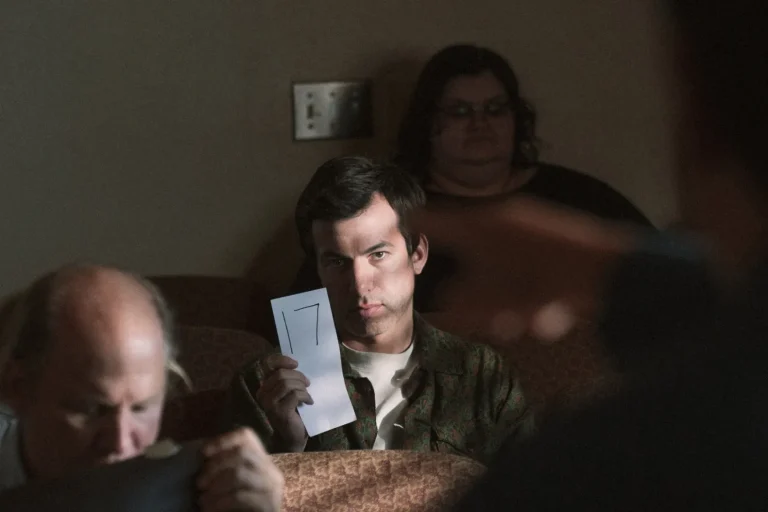Damien Chazelle’s latest feature Babylon (2022), is by far his most ambitious work yet. Set in the early Hollywood era, during the transition from silent films to talkies, the story follows a range of lively characters experiencing the highest of highs and the lowest of lows.
As another addition to the metatextual “love-letter-to-cinema” genre, the film has polarized audiences and critics alike. Much of this disparity in reception is due to the final scene, which, regardless of varying opinions, is perhaps the most unique ending, mainstream cinema has seen in the past couple of years. Such a finale warrants a careful analysis of the film’s thematic intentions.
The End of Fame: Jack Conrad’s Death
As we approach the finale, the three main characters come to the end of their respective journeys. A notable event is Jack Conrad’s (Brad Pitt) suicide. Leading up to this, Jack’s fame and reputation were fading.
An apt starting point for examining his character would be the revelation of his best friend’s death. Jack receives this news on the phone shortly before disputing his fiancé’s perception of cinema being a “low art.” “He was the first one to say I had talent,” says Jack as he starts mourning.
What’s particularly interesting here is that Jack never felt real emotion for anyone but himself. His four marriages only emphasize this point, and his friend’s death brings him pain because it means the death of belief in his reputation. Despite it being a cynical thought, Jack never really felt love for anyone but himself.
This makes Elinor St. John’s (Jean Smart) monologue all the more significant. She explains to Jack how they’re both easily replaceable in this cutthroat industry. Both will be forgotten soon after their fame subsides, and this conversation will be repeated many times. Any confidence in Jack’s image vanishes after this; he has no friends that will believe in him. His films don’t mean anything to his audience, and he will soon be forgotten. This is the reality that pushes Jack to suicide.
“LA’s last party”: Manny Torres’ Escape and Nellie LaRoy’s Death
In the other part of the story, Nellie LaRoy (Margot Robbie) tells Manny Torres (Diego Calva) that she is in debt to James McKay (Tobey Maguire). To avoid trouble with James and his men, Manny takes a friend with him and attempts to pay back the debt as soon as possible.
After the meeting, James insists that the two men come with him to the underground “LA’s last party.” What follows is a journey down a tunnel that could easily be labeled as a descent into hell. In this setting, Manny is exposed to the depths of human depravity, animalistic brutishness, and a chained alligator. He stares with terror as James uses his money to cheer on a man eating a live rat. Then, James discovers that Manny’s money is fake and attempts to kill him. Both Manny and his friend escape.
Manny finds Nellie and tries to help her escape LA. But as Manny leaves his car unattended, Nellie walks away. Manny’s friends are killed by one of James’ gunmen. However, he is spared. A montage shows us Jack’s funeral, in addition to news articles announcing Elinor’s death at 76 and Nellie’s being found dead in her hotel at the age of 34.
Manny’s Return to LA and the Final Montage
Almost thirty years later, in 1952, Manny returned to LA with his family. He stops at Kinoscope Studios and goes to a screening of Singin’ in the Rain. He’s reminded of his time working at the studios and the ambition he shared with Nellie, which makes him tear up. What follows is a montage of cinema throughout the years, punctuated with shots of celluloid-developing liquid.

We make technological leaps from silent movies to talkies, black-and-white to color in a matter of seconds. Furthermore, we get a glimpse into the future through the likes of Terminator 2, Jurassic Park, The Matrix, and Avatar. The film ends on Manny’s face, crying and smiling. Chazelle continues his tradition of ending a film on a stare. But instead of between two people, it’s between one person and the cinema.
The Magic of the Moving Pictures
The sequence is decidedly separate from the rest of the film in tone and form. Its Oscars-style approach and saccharine nature have put many people off, and understandably so. It seems like a cheap trick with an entirely unearned optimism, and yet it managed to leave an impact on me.
Any appreciation of cinema will likely, to some extent, please any cinephile. Babylon’s conflictingly hopeful ending, however, is an exception. It’s the equivalent of worshipping cinema and deifying it against the iniquities of humanity. The degree of ardor and passion here has the potential to melodramatize almost anything. Hence, the divisiveness fostered by the ending is expected. But how could the film not treat cinema in this way? It believes that cinema is humanity’s preserver and redeemer.
As excessive and far-fetched as this idea may seem, it becomes fully justified once contextualized with the rest of the film and the purpose of art. Throughout the story, we see nothing but self-indulgence, debauchery, racism, sexism, and callousness (there are multiple cases where character deaths are hastily skipped over).
Everything here is unforgivable, and the only exception to that is art. Art explores human beings’ interiors, psychology, dispositions, and spirituality. At its most fundamental, art is a claim that there is some meaning to human existence. Behind all the cruelty, there is something instead of nothing.
An optimistic ending to a nihilistic three hours can only be justified by placing some significance behind the nihilism. The means through which we achieve this is art or, in this case, cinema. Despite all the hopeless endings characters experience here, a part of their human lives is on in their art.
If someone engages with this art and sees themselves in it, the characters will be revived through the magic of mere moving pictures. In this way, cinema immortalizes whoever uses it as a form of self-expression.
Ambivalence through Artifice
Conversely, the films showcased in this final montage can also be seen as an exhibition of digital gimmicks that are yet to come, with no real opposition to the commercialization of cinema. Chazelle’s gleaming style furthers the visual artifice here, emphasizing the depiction of the Hollywood mainstream. There is, then, a sharp ambivalence to the ending, making it both hopeful and worrying. Still, the peace Manny finds with cinema is satisfying.
It’s an ending that will continue to create conflict in the coming years, but its audaciousness, misdirected or not, is undeniable. Despite its failure at the box office, Babylon’s choice to lean into a relative abstraction in its finale is an exciting detour from the convention. For that reason alone, it should not be forgotten so easily.







